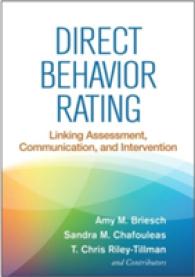基本説明
Thorough, authoritative treatment of one of the most controversial areas of linguistics.
Full Description
How are relationships established between the world's languages? This is one of the most topical and most controversial questions in contemporary linguistics. The central aims of this book are to answer this question, to cut through the controversies, and to contribute to research in distant genetic relationships. In doing this the authors aim to: (1) show how the methods have been employed; (2) reveal which methods, techniques, and strategies have proven successful and which ones have proven ineffective; (3) determine how particular language families were established; (4) evaluate several of the most prominent and more controversial proposals of distant genetic relationship (such as Amerind, Nostratic, Eurasiatic, Proto-World, and others); and (5) make recommendations for practice in future research. This book will contribute significantly to understanding language classification in general.
Contents
1. Introduction: how are languages shown to be related to one another?; 2. The beginning of comparative linguistics; 3. 'Asiatic Jones, Oriental Jones': Sir William Jones' role in the rise of comparative linguistics; 4. Consolidation of the comparative linguistics; 5. How some languages were shown to belong to Indo-European; 6. Comparative linguistics of other languages and regions; 7. How to show languages are related: the methods; 8. The philosophical-psychological-typological-evolutionary approach to language relationships; 9. Assessment of proposed distant genetic relationships; 10. Beyond the comparative method?; 11. Why and how do languages diversify and spread?; 12. What can we learn about the earliest human language by comparing languages known today?; 13. Conclusions: anticipating the future.







